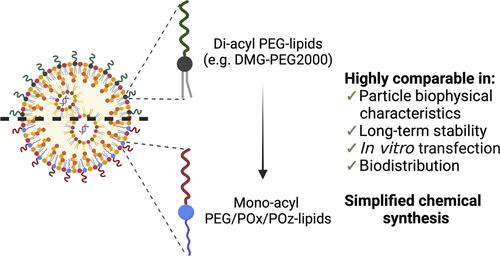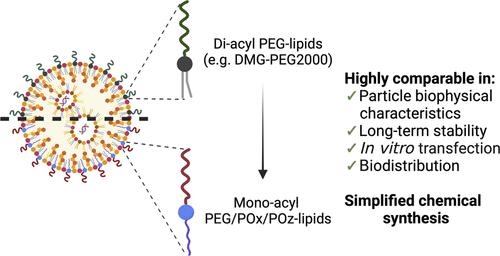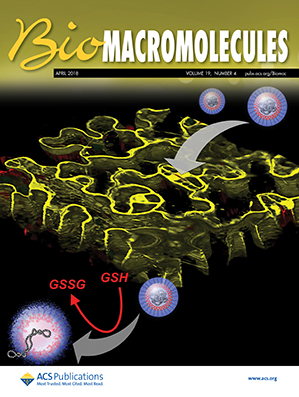定制的单酰基聚(2-噁唑啉)-和聚(2-噁唑)-类脂作为 PEG-类脂的替代品,用于稳定和输送 mRNA-类脂纳米颗粒。
IF 5.4
2区 化学
Q1 BIOCHEMISTRY & MOLECULAR BIOLOGY
引用次数: 0
摘要
将脂质纳米粒子(LNPs)成功用于 COVID-19 mRNA 疫苗的临床开发标志着 mRNA-LNP 疗法取得了突破性进展。作为 LNPs 的重要组成部分之一,聚乙二醇-脂质共轭物(PEG-脂质)会影响颗粒的生物物理特性和稳定性,以及在生物环境中的相互作用。有报告显示,在人类中可以很普遍地检测到抗 PEG 抗体,这不禁让人担心,商用 LNP 产品中的 PEG 成分可能会进一步激发对 PEG 的免疫反应。抗 PEG 抗体的存在与 LNPs 的加速清除有关,这可能是 mRNA-LNP 产品生物反应变异的一个来源。这促使我们探索潜在的 PEG 替代品。在此,我们报告了使用聚(2-噁唑啉)(POx)和聚(2-噁嗪)(POz)基聚合物-脂质共轭物组装的 mRNA-LNPs 的物理化学和生物学特性。值得注意的是,我们研究了单酰基脂质作为二酰基脂质的替代品。使用单酰基 POx/POz 脂质生产的 mRNA-LNPs 具有相似的生物物理特性和细胞相容性。与等效的 PEG 脂质相比,在粘附细胞、悬浮细胞和小鼠体内转染报告 mRNA 的效率相似。我们的研究结果表明,含有单酰基 POx/POz 脂质的 LNPs 是开发不含 PEG 的 LNP 治疗产品的理想候选材料。本文章由计算机程序翻译,如有差异,请以英文原文为准。


Tailored Monoacyl Poly(2-oxazoline)- and Poly(2-oxazine)-Lipids as PEG-Lipid Alternatives for Stabilization and Delivery of mRNA-Lipid Nanoparticles
The successful use of lipid nanoparticles (LNPs) for clinical development of the COVID-19 mRNA vaccines marked a breakthrough in mRNA-LNP therapeutics. As one of the vital components of LNPs, poly(ethylene glycol)-lipid conjugates (PEG-lipids) influence particle biophysical properties and stability, as well as interactions within biological environments. Reports suggesting that anti-PEG antibodies can be detected quite commonly within the human population raise concerns that PEG content in commercial LNP products could further stimulate immune responses to PEG. The presence of anti-PEG antibodies has been linked to accelerated clearance of LNPs, potentially a source of variability in the biological response to mRNA-LNP products. This motivated us to explore potential PEG alternatives. Herein, we report physicochemical and biological properties of mRNA-LNPs assembled using poly(2-oxazoline) (POx)- and poly(2-oxazine) (POz)-based polymer–lipid conjugates. Notably, we investigated monoacyl lipids as alternatives to diacyl lipids. mRNA-LNPs produced using monoacyl POx/POz-lipids displayed comparable biophysical characteristics and cytocompatibility. Delivery of reporter mRNA resulted in similar transfection efficiencies, in both adherent and suspension cells, and in mice, compared to PEG-lipid equivalents. Our results suggest that monoacyl POx/POz-lipid-containing LNPs are promising candidates for the development of PEG-free LNP-based therapeutic products.
- Download: Download high-res image (79KB)
- Download: Download full-size image
求助全文
通过发布文献求助,成功后即可免费获取论文全文。
去求助
来源期刊

Biomacromolecules
化学-高分子科学
CiteScore
10.60
自引率
4.80%
发文量
417
审稿时长
1.6 months
期刊介绍:
Biomacromolecules is a leading forum for the dissemination of cutting-edge research at the interface of polymer science and biology. Submissions to Biomacromolecules should contain strong elements of innovation in terms of macromolecular design, synthesis and characterization, or in the application of polymer materials to biology and medicine.
Topics covered by Biomacromolecules include, but are not exclusively limited to: sustainable polymers, polymers based on natural and renewable resources, degradable polymers, polymer conjugates, polymeric drugs, polymers in biocatalysis, biomacromolecular assembly, biomimetic polymers, polymer-biomineral hybrids, biomimetic-polymer processing, polymer recycling, bioactive polymer surfaces, original polymer design for biomedical applications such as immunotherapy, drug delivery, gene delivery, antimicrobial applications, diagnostic imaging and biosensing, polymers in tissue engineering and regenerative medicine, polymeric scaffolds and hydrogels for cell culture and delivery.
 求助内容:
求助内容: 应助结果提醒方式:
应助结果提醒方式:


